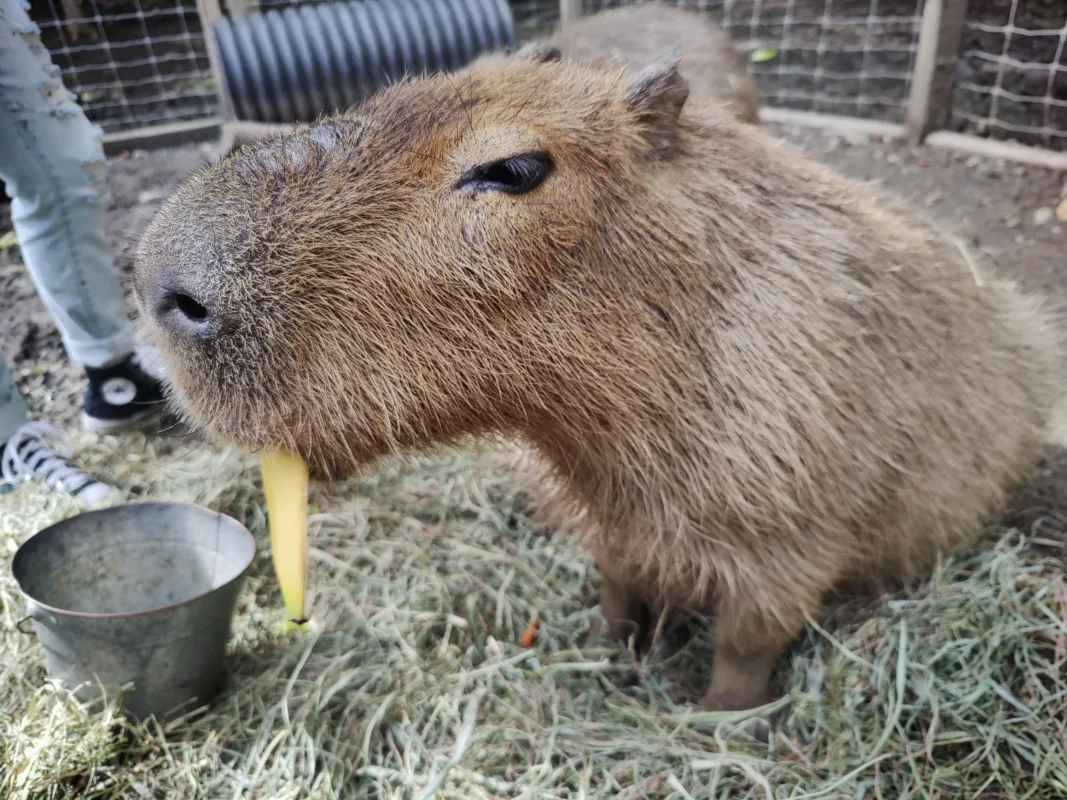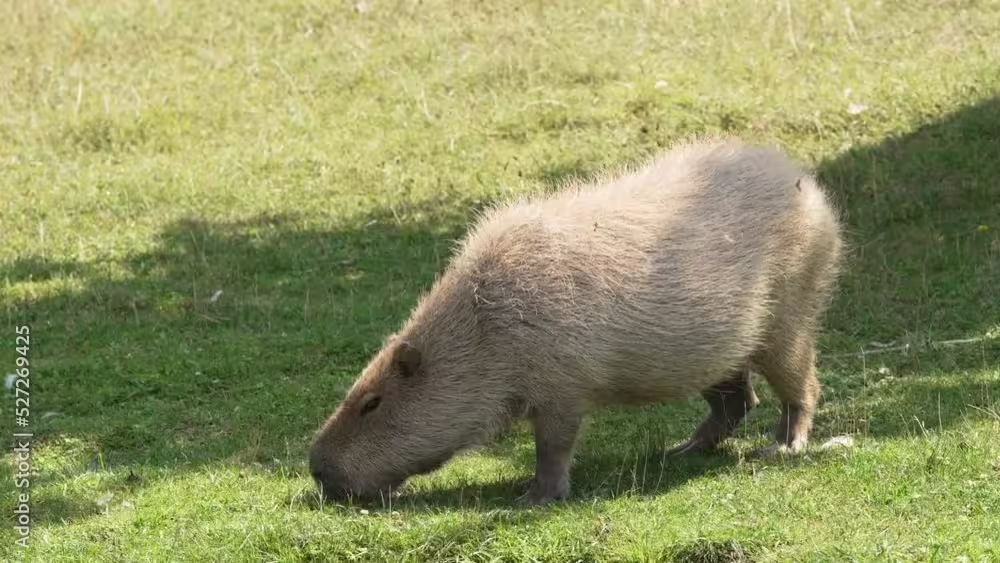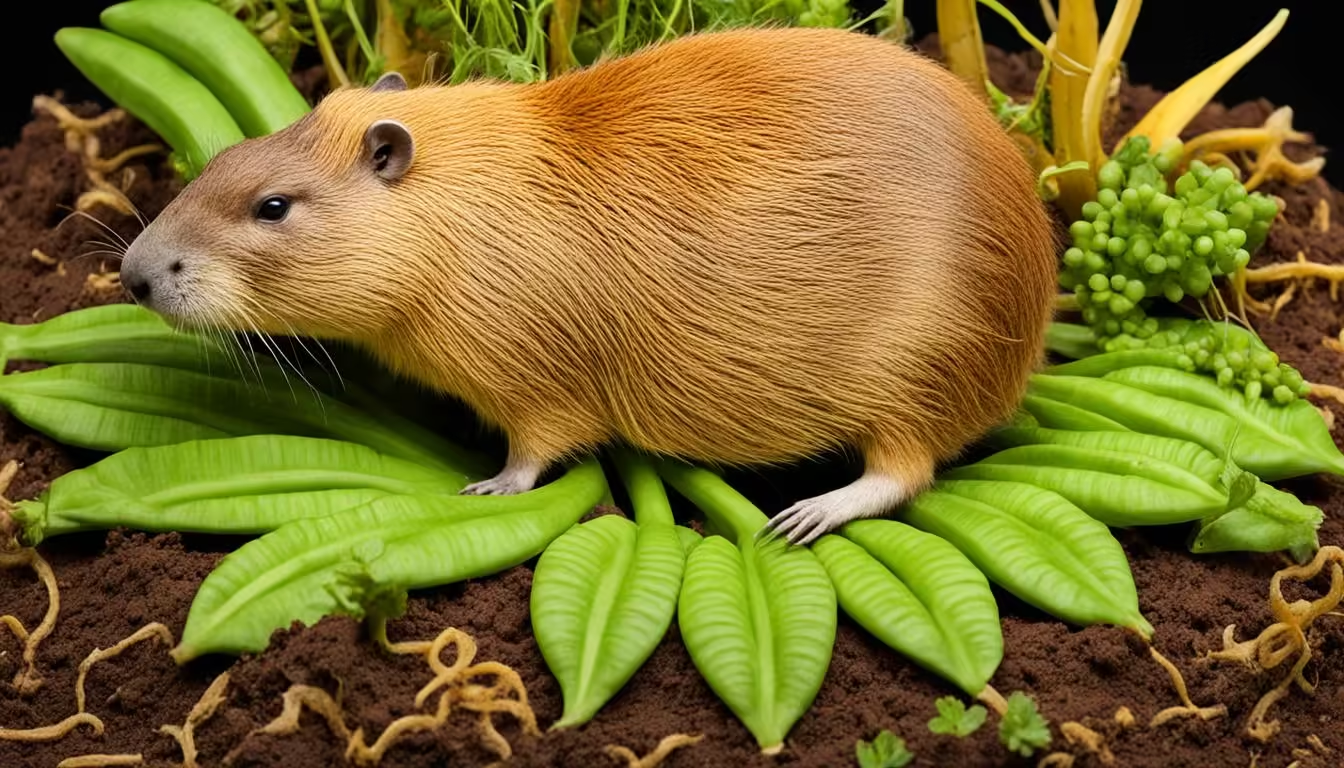Capybaras are the biggest rodents alive, found in South America’s wetlands. They have webbed feet and live partly in water. Their diet is mostly high-fiber and low-calorie foods like grasses and aquatic plants. But, can they have bananas as a special treat?
Key Takeaways
- Capybaras are specialized grazers, with grasses and sedges making up 70% of their diet in the wild.
- In their natural habitat, capybaras spend a significant portion of the day, up to 42% during the dry season, grazing on vegetation.
- While capybaras in Uruguay have been observed consuming cabbage, pumpkin, and carrots, with a preference for cabbage, feeding them sugary fruits like bananas can be detrimental to their health.
- Capybaras have unique dental adaptations, requiring constant chewing on high-fiber foods to maintain healthy teeth and prevent premature death.
- Providing capybaras with a diet that closely mimics their natural, high-fiber, low-nutrient diet is crucial for their optimal health and longevity.
Introduction to Capybaras
Capybaras are the biggest rodents alive today. They can be as long as four feet and weigh up to 140 pounds. This makes them huge among rodents. They live in water, near rivers, lakes, and marshes in South America.
The Largest Rodents in the World
Capybaras are the biggest rodents alive. Adult males can weigh about 50 kilograms. Females are a bit heavier, weighing around 61 kilograms. Their size helps them swim well and protect themselves from predators.
Semiaquatic Herbivores with Webbed Feet
Capybaras spend a lot of time in the water. Their webbed feet help them move through the water easily. They can dive and swim with skill. They eat aquatic plants, grasses, and bark, making them efficient herbivores.
They are social animals, living in groups of up to 20. They use sounds like barks, whistles, and grunts to talk to each other. This helps them stay close as a group.
“Capybaras are truly unique and fascinating creatures, combining their impressive size with an exceptional ability to thrive in aquatic environments.”
Capybaras are amazing because of their size, webbed feet, and social nature. They are interesting and inspiring to those who see them in the wild.
Do Capybaras Eat Bananas?
Capybaras eat a wide variety of foods, but people often wonder about bananas. These large rodents are mostly plant-eaters. Yet, the question of whether they should eat bananas is up for debate.
These animals mainly eat grasses, water plants, and tree bark. Bananas are high in sugar and not a key part of their diet. Giving them too many bananas or sugary fruits can be bad for their health.
| Food Item | Capybara Preference |
|---|---|
| Grasses | Preferred |
| Aquatic Plants | Preferred |
| Tree Bark | Preferred |
| Bananas | Not Preferred |
Some capybaras might eat a little banana as a special treat. But it shouldn’t be a big part of their diet. They need a diet rich in fiber to stay healthy.
In summary, capybaras might eat bananas sometimes, but they need a diet of grasses, water plants, and other natural foods. People taking care of these animals should focus on giving them the right food and living space.
Capybara Dietary Needs
Capybaras are the biggest rodents in the world. They have a special way of eating that helps them live off a diet high in fiber and low in calories. In the wild, they spend a lot of time eating grasses, aquatic plants, and tree and bush bark. This mix of foods gives them the nutrients they need and keeps their teeth growing.
High-Fiber, Low-Calorie Diet
Capybaras eat only plants. Their stomachs are made to break down tough plant material well. They can eat up to six to eight pounds of grass every day, which is about 3% to 4% of their body weight.
Grasses, Aquatic Plants, and Bark
- Grasses and aquatic plants are the main foods for capybaras.
- They should only have a little bit of fresh veggies and fruits to avoid stomach problems.
- In captivity, high-quality grass hay is key to their diet.
- In the wild, capybaras eat together, which helps them find more food.
The foods capybaras eat are important for their health and also help the environment. They eat so much that it helps control plant growth and makes the soil better through their poop.
“Capybaras usually eat around two to four pounds of food per day in a zoo setting.”
Knowing what capybaras need to eat helps us make sure they are well-fed. This is true whether they are in a zoo or living in the wild.
The Importance of a Balanced Diet
Keeping a balanced diet is key for capybaras’ health and happiness. These unique rodents need certain nutrients to live long and stay healthy. Eating too much sugar or the wrong foods can cause health problems like digestive issues, tooth problems, and even death.
Capybaras eat mainly grasses, water plants, and tree bark. These foods are good for their complex digestive system. It’s important to feed them like they would forage in the wild to keep them healthy in body and mind.
| Nutrient | Importance for Capybaras | Sources in a Balanced Diet |
|---|---|---|
| Fiber | Supports healthy digestion and prevents gastrointestinal issues | Grasses, aquatic plants, and tree bark |
| Protein | Supports muscle development and overall body condition | Leaves, shoots, and other plant matter |
| Vitamins and Minerals | Promotes immune function, bone health, and overall well-being | Variety of plant sources, including leafy greens and fruits |
Feeding capybaras a balanced diet that matches their wild diet helps them stay healthy. This is good for the capybara and helps protect this special species.
“Maintaining a balanced diet is essential for the long-term health and well-being of capybaras. Neglecting this can have serious consequences for these remarkable animals.”
We will look at what capybaras need to eat, the risks of giving them the wrong foods, and why the right care and environment matter for their diet.
Dangers of Feeding Capybaras Inappropriate Foods
Capybaras, the biggest rodents, have a sensitive stomach. They can’t handle foods high in sugar, like candy or ice cream. Giving them these foods can harm their health badly.
Sugar and Stress: Potential Health Risks
Eating too much sugar can cause stomach problems, liver issues, and heart issues in capybaras. It can also make them stressed. Capybaras are very sensitive and need a special diet to stay healthy.
It’s important to know the dangers of feeding capybaras inappropriate foods. Their health and long life depend on eating a diet rich in fiber and low in calories. Foods like grasses, aquatic plants, and bark are best for them. Giving them the right food helps them stay healthy and happy.
“The well-being of capybaras is closely tied to their dietary needs. Feeding them unsuitable foods can lead to serious health problems and even threaten their lives.”
Don’t give capybaras human snacks or treats. Instead, feed them their natural food. This helps keep these amazing animals healthy and happy.
Unique Digestive System of Capybaras
Capybaras, the biggest rodents, have a special digestive system. It’s made to handle their diet of high-fiber, low-calorie foods. Their key feature is the cecum, a big pouch that helps break down food.
As semiaquatic herbivores, capybaras eat grasses, water plants, and bark. These foods are hard to digest. Their large cecum, making up to 40% of their gut, is full of microorganisms. These microbes help break down tough plants.
| Digestive Trait | Capybara Adaptation |
|---|---|
| Cecum Size | Capybaras have a remarkably large cecum, which can make up 40% of their entire digestive tract. |
| Fermentation | The cecum acts as a fermentation chamber, housing a diverse community of microorganisms that break down tough plant materials. |
| Nutrient Extraction | This specialized digestive system allows capybaras to extract the maximum amount of nutrients from their low-calorie, high-fiber diet. |
The capybara’s digestive system is unique. It helps them live on a diet hard for others to digest. With their cecum and its microbes, they turn tough plants into energy and nutrients.
Capybaras as Pets: Dietary Considerations
Capybaras can make interesting and loving pets. But, they need the right care and diet to stay healthy. These large rodents have special dietary needs that pet owners must consider.
Providing the Right Environment and Diet
Capybaras live in water and eat plants. To keep them healthy, they need a big outdoor area with water. Their diet should mainly be fresh grass, hay, and guinea pig feed.
- Grass is key for their diet, giving them the fiber and nutrients they need.
- Hay is also good, but shouldn’t take the place of grass.
- Guinea pig feed can add more nutrients, but don’t give too much to avoid weight gain.
Feeding capybaras right is important because they digest food differently. They need a diet high in fiber and low in calories. Giving them the right food and space is key to their health.
| Nutrient | Critical Care for Herbivores |
|---|---|
| Crude Protein | 17.00% |
| Crude Fat | 5.00% |
| Crude Fiber | 21.00% – 26.00% |
| Moisture | <10.00% |
| Calcium | 0.60% – 0.80% |
| Phosphorus | 0.40% |
| Vitamin A | 10,000 IU/kg |
| Vitamin D3 | 900 IU/kg |
| Vitamin E | 190 IU/kg |
| Ascorbic Acid (Vitamin C) | 1,500 mg/kg |
| Metabolizable Energy | 2,660 kcal/kg or 24 kcal/Tbsp. |
The table shows the important nutrients in Critical Care for Herbivores. This formula meets the dietary needs of pet capybaras. By knowing what these animals need, pet owners can give them the best care and nutrition.
Symbiotic Relationships with Birds
Capybaras, the biggest rodents, have formed special bonds with some bird species. These bonds show how closely they work together in their natural homes. For example, they have a mutual relationship with the wattled jacana.
These birds sit on the capybaras and eat insects on their skin. It’s like a free spa for the capybaras. In return, the capybaras get rid of parasites thanks to the birds. This shows how capybaras and birds work together, highlighting their capybara-bird symbiotic relationships and capybara interactions with other species in their capybara ecology.
Capybaras also connect with other bird species, showing their flexibility and the complex networks in their ecosystems. These partnerships help the animals involved and make their habitats more balanced and strong.



